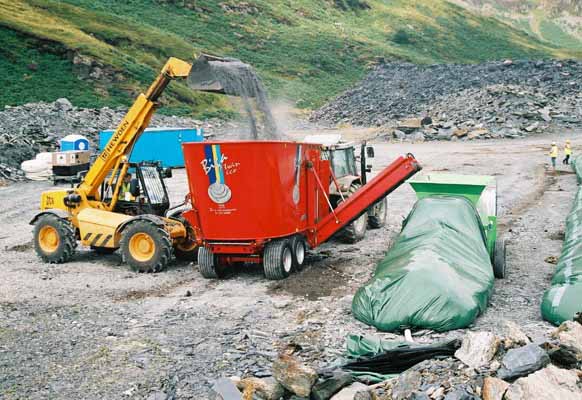- Home Page
- Composting
- Decomposition
Aims
Feedstock and Compost Mixes
Compost Production and Application - Land Restoration
- Quarry Sites
Urban Brownfield Sites
Mine Sites
Colliery Sites - Restoration results
- Quarry site - Blaenau Ffestiniog
Urban Brownfield site - Shotton
Mine site - Greece
Colliery site - Woolley Colliery - Dissemination and Publications
- Forthcoming Events
Previous Events
Open Days
TWIRLS Newsletters
Scientific Publications
Media Archive
Best Practice - Manuals and Tools - Information Services
- Best Practice - Manuals and Tools
- Our Staff

TWIRLS: Treating Waste for Restoring Land Sustainability
Site Restorations - Quarry site -Blaenau Ffestiniog
Site Restorations Menu
Producing compost from mixed organic and mineral wastes using portable plant and sealed composting vessels
Inaccessible quarry sites in areas of high conservation value present particular challenges for restoration using organic wastes. At Blaenau Ffestiniog, the TWIRLS project used EcoPOD® sealed composting vessels under a Paragraph 12A exemption to the Waste Management Licensing Regulations. Sealed systems offer several advantages when used at sensitive sites. A particular concern of the EA is the production of leachate; this is contained in sealed vessels which may also allow greater process control and reduced production of odours. A major advantage of using sealed systems is one of public acceptance; we have found that community leaders, EA and Local Planning Authority officers perceive small to medium sized in-vessel systems to be safer (in terms of the environment and human health) than open-air windrows. Regulatory and planning approval for composting, particularly when considered by committee, may be swifter for in-vessel systems. Sealed systems should not be used in all situations. They are more expensive and consume extra fuel and materials when compared with windrows.
 Left, either de-inking paper fibre, an infertile by-product of recycling paper fibre, or slate mineral fines (a quarry by-product) are loaded into a vertical auger cattle feed mixer wagon together with tertiary-treated sewage sludge and green waste shredded at a local authority site (Conwy BC). Wastes are mixed in batches of 15 m3 and conveyed into a CT5 EcoPOD® filling machine which uses a hydraulic ram to push the material through a filling chamber into an extending 1.5 m diameter plastic bag. At the same time as filling the EcoPOD®, a perforated plastic aeration pipe is simultaneously fed along the base of the bag to provide aeration. The aeration regime is controlled by a timed fan powered by a diesel generator.
Left, either de-inking paper fibre, an infertile by-product of recycling paper fibre, or slate mineral fines (a quarry by-product) are loaded into a vertical auger cattle feed mixer wagon together with tertiary-treated sewage sludge and green waste shredded at a local authority site (Conwy BC). Wastes are mixed in batches of 15 m3 and conveyed into a CT5 EcoPOD® filling machine which uses a hydraulic ram to push the material through a filling chamber into an extending 1.5 m diameter plastic bag. At the same time as filling the EcoPOD®, a perforated plastic aeration pipe is simultaneously fed along the base of the bag to provide aeration. The aeration regime is controlled by a timed fan powered by a diesel generator. 
Right, Instead of usual agricultural equipment for applying compost, we used machines available on-site (a telescopic handler and tracked excavator) to spread the composts to approximately 1000 t ha-1.
Spreading compost and managing fertility during restoration of an upland quarry
Composts produced at Blaenau Ffestiniog were too fertile to use at the restoration trial site without further modification. For composting to proceed properly and reach the high temperatures required to kill pathogens and sterilise weed seeds it is necessary to keep the initial C:N ratio of mixed feedstocks between ca 25 and 35. Inevitably, composts produced from this initial C:N ratio contain amounts of nutrients in excess of the requirements of biodiverse target habitats. Whilst fertile compost may be fine for establishing amenity grassland, it contains as much as 200 times more plant available phosphorus per unit weight than natural soils supporting heathland, upland or biodiverse grassland. Thus, there is a real danger of creating a monoculture of a highly competitive grass species, e.g. Red fescue, Festuca rubra, at the expense of more diverse, early successional plant communities.
Managing compost fertility is complex and a variety of approaches can be taken. These include diluting compost with inert mineral wastes or quarry by-products, mixing with infertile organic wastes that also biologically immobilise nutrients, chemically ameliorating compost to ‘lock-up’ nutrients in less available forms or intensively managing the resulting grass sward to remove nutrients in biomass. At Blaenau Ffestiniog, we mixed finished compost with de-inking paper fibre at a rate of 1:1 by dry weight. This not only halved the availability of phosphorus, it also increased the water-holding capacity of the substitute soil from 0.87 to 1.34 g plant available water per g dry compost.
The finished composts passed BSI PAS 100 quality criteria and after diluting with de-inking paper fibre or slate mineral fines they were spread to approximately 0.5 ha of prepared slate quarry waste under a Paragraph 9A exemption (ecological improvement) to the Waste Management Licensing Regulations. In order to test that the composts were suitable for restoring low nutrient habitats, a vegetation establishment experiment was laid out according to a randomised block design. Plots were seeded at a rate of approximately 40 kg ha-1 either with a mixture of native grasses (Agrostis capillaris and Festuca ovina at a ratio of 1:4), heather (Calluna vulgaris), or with heather and grass together.
 Left, the vegetation establishment experiment in July 2006 (eight months after seeding). The most fertile plots already have ca 80% cover of sown grasses.
Left, the vegetation establishment experiment in July 2006 (eight months after seeding). The most fertile plots already have ca 80% cover of sown grasses.
 Right, floristic surveys indicate that addition of paper fibre to finished compost increases germination of heather.
Right, floristic surveys indicate that addition of paper fibre to finished compost increases germination of heather.

